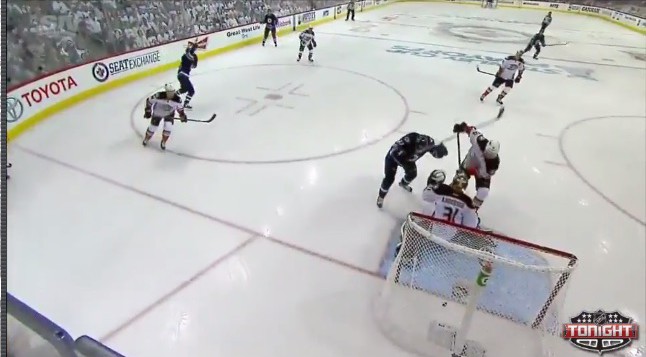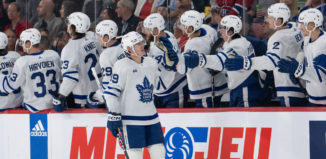Winnipeg Jets White Out Not Enough
(Photo: jets.nhl.com)
If you were watching the Winnipeg Jets hosting their first playoff game in nineteen years on Monday night then you saw nothing but white in the stands. It was a shame that the NHL couldn’t have let the Jets wear their white jerseys, as sometimes happens when a visiting team wants to wear a third jersey. However, the enthusiasm that filled the arena was powerful. And while the Jets couldn’t get the win they at least forced the Anaheim Ducks to go to overtime.
The decibel levels at the MTS Centre reached the 120s on Monday night and with each move of their beloved team, the rally tallies were going and the chants were palpable. It was no doubt part of this energy that ensured that as the Ducks got one in the net the Jets responded.
The energy generated by the fans is not simply a cliché mentioned by the players at moments in the season when they feel they should acknowledge them. There are barns in which it is extremely difficult to win if the crowd is involved—and often a key to the game for the visiting team is to try and silence that crowd and thus take that energy away from the home team. Home ice offers more than just the advantage of knowing how the pucks bounce off the boards. It’s having that hometown crowd willing its team to score and win.
After the Jets got on the board first with the wrist shot by Lee Stempniak that got past Frederik Andersen at 9:38 of the first, the crowd showed their appreciation. It looked like the Jets would get out of the first period with the lead when Cam Fowler’s wrister got past Ondrej Pavelec with just seven seconds remaining on the clock. Never the way either team wants to go to the locker room, having allowed the opposition to score within the last few seconds. Usually it results in that scoring team having the momentum when the game resumes.
Such was the case when Corey Perry’s slapshot put the Ducks up by one just 3:08 into the second period. Much was said by the announcers as to how important it was for the Jets to respond. And those in MTS Centre were noticeably quieter.
Of all the goals that were scored Monday night, only the Jets tying goal at 6:40 of the second from the wrist shot of Tyler Myers would be a power play goal. The second period would also see the most goals scored in a period of the game with the back and forth of five goals—two for Anaheim and three for the Jets.
After tying the score, the Jets would get the go ahead goal from Blake Wheeler’s snap shot at 9:37 of the period and the score would stall there until 16:04 when Jakob Silfverberg’s snap shot would again tie the game –three apiece. The Jets would answer though just 2:14 later off the stick of Bryan Little who had a slapshot to again put the home team up by a goal.
Once again the score would stall and it looked like perhaps the White Out would have its chance to truly embrace a win in its first home playoff game, when the Ducks refused to back down. Ryan Kesler tied the score at 17:46 of the third and the game would end up going to overtime, where a deflection by Rickard Rakell would give the Ducks the win and a three game lead in the series.
As has been seen in recent years, a three game lead is no guarantee that the leading team will continue on in the playoffs. The Ducks will again be forced to play against the Jets while dealing with the energy of the fans on Wednesday for game four of this series, which will air on USA at 9:30 ET. And as often happens with a team facing elimination, it is likely that the Jets will pull out all the stops and do whatever they can to ensure they don’t lose the series in a sweep in their home arena.
Highlights of Game Three:














